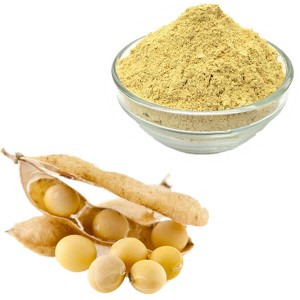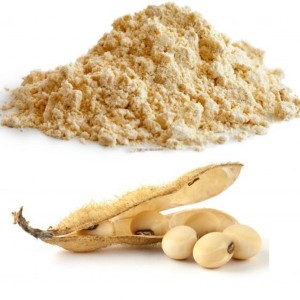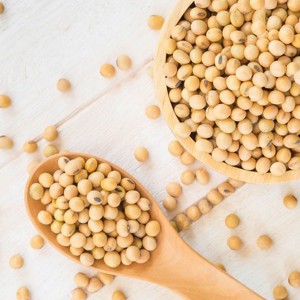Soy Peptide
Flow Chart

Application
1) Food uses
Soy protein is used in various foods, such as salad dressings, soups, meat analogues, beverage powders, cheeses, nondairy creamer, frozen desserts, whipped topping, infant formulas, breads, breakfast cereals, pastas, and pet foods.
2) Functional uses
Soy protein is used for emulsification and texturizing. Specific applications include adhesives, asphalts, resins, cleaning materials, cosmetics, inks, pleather, paints, paper coatings, pesticides/fungicides, plastics, polyesters, and textile fibres.

Amino Acid Content List
|
NO. |
AMINO ACID CONTENT |
Test results (g/100g) |
|
1 |
Aspartic acid |
15.039 |
|
2 |
Glutamic acid |
22.409 |
|
3 |
Serine |
3.904 |
|
4 |
Histidine |
2.122 |
|
5 |
Glycine |
3.818 |
|
6 |
Threonine |
3.458 |
|
7 |
Arginine |
1.467 |
|
8 |
Alanine |
0.007 |
|
0 |
Tyrosine |
1.764 |
|
10 |
Cystine |
0.095 |
|
11 |
Valine |
4.910 |
|
12 |
Methionine |
0.677 |
|
13 |
Phenylalanine |
5.110 |
|
14 |
Isoleucine |
0.034 |
|
15 |
Leucine |
6.649 |
|
16 |
Lysine |
6.139 |
|
17 |
Proline |
5.188 |
|
18 |
Tryptophane |
4.399 |
|
Subtotal: |
87.187 |
|
Average Molecular Weight
Test method: GB/T 22492-2008
|
Molecular weight range |
Peak area percentage |
Number average molecular weight |
Weight average molecular weight |
|
>5000 |
1.87 |
7392 |
8156 |
|
5000-3000 |
1.88 |
3748 |
3828 |
|
3000-2000 |
2.35 |
2415 |
2451 |
|
2000-1000 |
8.46 |
1302 |
1351 |
|
1000-500 |
20.08 |
645 |
670 |
|
500-180 |
47.72 |
263 |
287 |
|
<180 |
17.64 |
/ |
/ |
|
Iterms |
Standard |
Test based on |
|
|
Organizational form |
Uniform powder, soft, no caking |
GB/T 5492 |
|
|
Color |
White or light yellow powder |
GB/T 5492 |
|
|
Taste and smell |
Has the unique taste and smell of this product, no peculiar smell |
GB/T 5492 |
|
|
Impurity |
No visible exogenous impurity |
GB/T 22492-2008 |
|
|
fineness |
100% pass through a sieve with an aperture of 0.250mm |
GB/T 12096 |
|
|
(g/mL)Stacking Density |
—– |
|
|
|
(%,dry basis)Protein |
≥90.0 |
GB/T5009.5 |
|
|
(%, dry basis)content of peptide |
≥80.0 |
GB/T 22492-2008 |
|
|
≥80% relative molecular mass of peptide |
≤2000 |
GB/T 22492-2008 |
|
|
(%)Moisture |
≤7.0 |
GB/T5009.3 |
|
|
(%)Ash |
≤6.5 |
GB/T5009.4 |
|
|
pH value |
—– |
—– |
|
|
(%)crude fat |
≤1.0 |
GB/T5009.6 |
|
|
Urease |
Negative |
GB/T5009.117 |
|
|
(mg/kg)Sodium content |
—– |
—– |
|
|
(mg/kg) Heavy Metals |
(Pb) |
≤2.0 |
GB 5009.12 |
|
(As) |
≤1.0 |
GB 5009.11 |
|
|
(Hg) |
≤0.3 |
GB 5009.17 |
|
|
(CFU/g)Total Bacterias |
≤3×104 |
GB 4789.2 |
|
|
(MPN/g) Coliforms |
≤0.92 |
GB 4789.3 |
|
|
(CFU/g)molds and yeast |
≤50 |
GB 4789.15 |
|
|
Salmonella |
0/25g |
GB 4789.4 |
|
|
Staphylococcus aureus |
0/25g |
GB 4789.10 |
|
Flow Chart For Soy Peptide production
1) Food uses
Soy protein is used in various foods, such as salad dressings, soups, meat analogues, beverage powders, cheeses, nondairy creamer, frozen desserts, whipped topping, infant formulas, breads, breakfast cereals, pastas, and pet foods.
2) Functional uses
Soy protein is used for emulsification and texturizing. Specific applications include adhesives, asphalts, resins, cleaning materials, cosmetics, inks, pleather, paints, paper coatings, pesticides/fungicides, plastics, polyesters, and textile fibres.
Package
with pallet:
10kg/bag, poly bag inner, kraft bag outer;
28bags/pallet, 280kgs/pallet,
2800kgs/20ft container, 10pallets/20ft container,
without Pallet:
10kg/bag, poly bag inner, kraft bag outer;
4500kgs/20ft container
Transport & Storage
Transport
The means of transportation must be clean, hygienic, free of odor and pollution;
The transportation must be protected from rain, moisture, and exposure to sunlight.
It is strictly forbidden to mix and transport with toxic, harmful, peculiar smell, and easily polluted items.
Storage condition
The product should be stored in a clean, ventilated, moisture-proof, rodent-proof, and odor-free warehouse.
There should be a certain gap when food is stored, the partition wall should be off the ground,
It is strictly forbidden to mix with toxic, harmful, odorous, or pollutant items.























